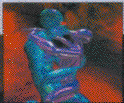Definitions in VR and IV
 There are two sections of definitions I want to look at. The first is a look a dictionary definitions of VR and IV. The second is a look at terminology commonly seen in connection with VR and IV.
There are two sections of definitions I want to look at. The first is a look a dictionary definitions of VR and IV. The second is a look at terminology commonly seen in connection with VR and IV.
Virtual - Being in essence or effect, not in fact; not actual but equivalent, so far as result is concerned.
Reality - The state or quality of being real; actual being or existence; actuality; truth; fact; that which is real as opposed to that which is imagination or pretense.
Information - The act of informing; news or intelligence communicated by word or writing; intelligence; knowledge derived from reading or instruction, or gathered in any way; a statement of facts laid before a court of justice.
Visualization - To form a mental picture of anything; to make visible.
Artificial Reality - Introduced by arts and computer visualization
scholar Myron Krueger in the mid-1970s to describe his computer-
generated responsive environments. Krueger has emphasized the
non-intrusive (Second - Person VR) systems that track people with
pattern recognition techniques and display them and the surround on
projection systems (see CAVE). As realized in his VIDEOPLACE and the
Vivid Group's Mandala system, it is a computer display system that
perceives and captures "a participant's action in terms of the body's
relationship to a graphic world and generates responses (usually
imagery) that maintain the illusion that his actions are taking place
within that world." (M. Krueger, Artificial Reality, 1992) (See
Virtual Reality and Cyberspace)
Augmented Reality - The use of transparent HMDs to overlay computer generated images onto the physical environment. Precisely calibrated, rapid head tracking
is required to maintain cohesion.
Cyberspace - This term was originally coined by William Gibson, in "Neuromancer", to describe the shared virtual universe of the world's computer networks, where both participants and data could be seen, heard, and touched. This term has come to describe the more familiar global information space. Our telephone conversations, Usenet discussions, and ATM transactions all take place in cyberspace.
Holodeck - Virtual reality simulation system and place used primarily
for entertainment by the crew of the Enterprise in Star Trek: The Next
Generation television series.
Presence - The feeling of actually being in an environment, whether it is real, augmented, or virtual. This is a defining characteristic of an immersive VR system.
Simulator sickness(eg. DOOM sickness) - The disturbances produced by simulators, ranging
in degree from a feeling of unpleasantness, disorientation, and
headaches to nausea and vomiting. Many factors may be involved,
including sensory distortions such as abnormal movement of arms and
heads because of the weight of equipment; long delays or lags in
feedback, and missing visual cues from convergence and accommodation.
Simulator sickness rarely occurs with displays less than 60 degrees
visual angle.
Virtual Reality (VR) -
This term is attributed to Jaron Lanier, to describe an immersive,
interactive simulation of realistic or imaginary scenes. Common usage
of this term would indicate that the immersive component is not
required. However, many researchers strongly believe that immersion
is as important as interactivity.
Visualization - Use of computer graphics to make visible numeric or
other quantifiable relationships.
Next Topic
Previous Topic
Last updated Tuseday March 21, 1995
 There are two sections of definitions I want to look at. The first is a look a dictionary definitions of VR and IV. The second is a look at terminology commonly seen in connection with VR and IV.
There are two sections of definitions I want to look at. The first is a look a dictionary definitions of VR and IV. The second is a look at terminology commonly seen in connection with VR and IV.